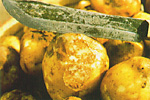Late Blight of Potatoes

Potato plant with late blight.
Photo courtesy W.
E. Fry
Causal Agent
Phytophthora infestans
Class of Pathogen
Fungus
Order of Fungal Pathogen
Oomycota
Host Plant
Potato, Tomato
Geographical Distribution
Late blight disease is found
in nearly all areas of the world where potatoes and tomatoes are grown.
As learned through the Irish Potato Famine, late blight is most commonly
found in areas of cool, moist climate. Total destruction of a field
may occur within a week or two if favorable weather patterns persist.
Also, potatoes harvested may become infected and rot while in storage.
Symptoms
The first noticeable symptom
of late blight comes as water-soaked spots form, usually at the edges of
the lower leaves. Chlorotic borders may also be present during periods
of moist weather. White fungal growth 3 to 5 mm wide will appear
on the underside of leaf lesions. Infected leaves soon become limp
and die.
Tubers infected will show
purple/brown areas of flesh exteding 5 to 15 mm into the potato.
Later on, these areas may dry and become firm and sunken in. This
rotting of the potato continues after the tubers are harvested and become
prone to other fungi and bacteria. Rotting potatoes will have an
offensive odor.

Infected tubers have a purplish/brown color.
Photo courtesy of http://www.apsnet.org/
Dissemination and Disease
Cycle
The pathogen Phytophthora
infestans overwinters as mycelium in infected potato tubers, debris,
and soil. Reproduction occurs both sexually and asexually.
However, sexual reproduction in nature is extremely rare. In asexual
reproduction, come spring, sporangia are produced. Sporaniga are
carried to new plants through both air and water. If cold conditions
persist, sporangia will germinate indirectly through zoospores. If
warmer temperatures persist, germination will occur via germ tubes.
These sporangia and zoospores infect potato leaves. After infection,
sporangium may continue to be produced by sporangiophores, which may continue
to infect other portions of the plant. As the disease develops, older
lesions continue to enlarge as new ones develop.
The second phase of late
blight occurs with the infection of the actual tubers. As sporangia
are washed down from the leaves they carry through the soil and infect
the tubers. Zoospores germinate and penetrate the tubers through
either scarred tuber tissue or lenticels. It is common for tubers
to rot in the ground and in storage.
For disease cycle of late
blight of potato, CLICK HERE.
Control Measures
Late blight of potatoes
can be controlled successfully through a combination of various measures.
No cultivars are immune to late blight, and cultivars with greater resistance
should be planted. Destruction of volunteer plants should be conducted
as well, since such plants may be a source of disease. New varieties
may be resistant to vine infection, but tuber infection is still a possibility.
Moderate disease control
is often obtained through cultural practices. Selecting a site with
adequate drainage and sufficient air movement will help reduce moist conditions.
Rotation of crops will help to minimize pathogen levels. Along with
crop rotation, residue management will help to keep pathogen levels low.
Chemical options exist for
the control of late blight as well. Materials include mancozeb, metalaxyl,
chlorothalonil, and copper materials similar to Bordeaux mixture. Chemical
control helps prevent tuber losses. However, it is still necessary
to combine chemical control with cultural control methods.
References
Agrios, George N.
Plant Pathology Fourth Ed. Academic Press 1997. pp 275-278.
http://www.bcc.orst.edu/lateblight/
Accessed 2/10/01
Related Journal Article
Powelson, M. L., and Inglis,
D. A. 1999. Foliar fungicides as protective seed piece treatments
for management of late blight of potatoes. Plant Dis. 83:265-268
Summary
Planting seed tubers
contaminated with Phytophthora infestans is one of the causing factors
of late blight epidemics. Thus, it is important to insure that seeds
are free of tuberborne pathogens. The research conducted by Powelson
and Inglis looked at several treatments that possessed Section 18 (Emergency
Use) labels. Under greenhouse conditions three Section 18 products
were studied; Acrobat MZ, Curzate M-8, and Tattoo C. Of the three
studied, Curzate M-8 was frequently the most effective. Overall,
controll of tuber borne inoculum of P. infestans with approriate
seed piece treatments resulted in an increase in plant emergence and improved
crop uniformity. Effective control of P. infestans was compounded
when use of resistant cultivars was coupled with the use of fungicide sprays.


